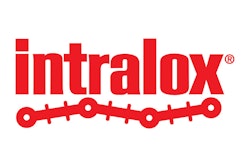A three-legged secondary-packaging system has brought Latrobe Brewing Co. of Latrobe, PA, to the head of the class where high-speed automation and Just-In-Time manufacturing are concerned. With two 108-valve fillers feeding 12-oz glass bottles to three secondary packaging legs, the line is designed to handle 1길 bottles/min with just eight operators assisting. The $14.5 million line replaces a system that ran half as fast and required twice as many operators.
“We haven’t installed a new line in 20 years,” says Bill Allison, packaging manager at the brewery. “So this was quite a step for our people, considering how much technology has changed. It really represents a shift in staffing philosophies, so that instead of having people feel like they’re assigned to a specific packaging machine, we have people responsible for specific areas that they patrol.”
The line was sold and installed by the Beverage Division of Italy’s Sasib S.p.A as a turnkey project, including engineering and project management. The SIG Group of Switzerland recently acquired Sasib’s Beverage Division, which is now called SIG-Simonazzi (Plano, TX).
The sophisticated equipment used to carry packaging materials into the line is a story in itself (see p. 44). But the heart of the line is a pair of 108-valve Eurotronica fillers from SIG (see video). Flanking each filler are a 108-head rinser and a rotary crowner, also from SIG.
On the Eurotronica filler, each electronically controlled valve has its own microprocessor, which receives signals from a PLC. These signals govern the valve’s opening and closing operations according to a preset sequence. A level probe measures fill height, and that information is relayed via the valve’s microprocessor to the PLC, which stores the information.
Because each filling sequence is electronically logged in this way, any individual valve that malfunctions will be quickly detected. If, for example, valve 47 is underfilling each time, an operator can reprogram that valve through the computer control system to stay open, say, one-tenth of a second longer. Later, during scheduled maintenance, the valve can be examined, but in the meantime its filling accuracy can be restored on the fly.
Ink-jet coding
Also applied to each bottle, just before each rinser, is “born on” dating. It’s done by a Videojet ink-jet coder from Marconi Data Systems (Wood Dale, IL).
As bottles leave the crowner, they’re conveyed through a RetroVision machine vision system from Industrial Dynamics (Torrance, CA) that detects improperly seated crowns. A few feet later, fill height is inspected by an Industrial Dynamics Filtec system.
Following these inspections, bottles are combined in a mass flow and then split again so they can be sent through an energy-efficient double-deck pasteurizer from SIG-Simonazzi’s Pama Div. Allison says the pasteurizer uses about 13 gal of water/min and consumes steam at a rate of less than 1ꯠ lb/hr when bottles are running at 1길/min. Latrobe’s previous line, he adds, required 120 gal of water/min and 4ꯠ lb of steam/hr for bottles running at 800/min.
After 52 minutes in the pasteurizer, where the beer is raised from 34°F to 144°F and then quickly cooled, bottles are conveyed from the pasteurizer on two levels. On each level, a magnetic transfer device from Freddi (Parma, Italy) grabs bottles by their steel crowns and carries them over a gap before releasing them on the other side. This ensures that if there are any bottles that have fallen over on the conveyor belt, they’ll drop through the gap and won’t compromise the packing equipment downstream.
At this point bottles are combined again into a single mass flow. Now they proceed toward one of three secondary-packaging legs. Legs One and Two, used to pack 12 bottles loose or four six-pack basket carriers in a corrugated shipper, are identical. They include a Model 2060 robotic case-blank feeder from Pearson Packaging Systems (Spokane, WA), a Pearson 208 case erector, a Pearson basket erector, an Accutech Design Ltd. (London, Ontario, Canada) stuffer that puts baskets into the 12-count cases, a Hartness (Greenville, SC) OctoPack™ continuous-motion place packer, a Domino Amjet (Gurnee, IL) laser coder for date and lot coding on corrugated cases, and an Accutech case sealer with full-case inspection capability. [See video clips of Latrobe's Pearson and Hartness equipment.]
Leg Three differs in that it has no basket erectors. That’s because six-pack carriers are not handled on this leg. Instead, it does 12-counts loose or 24-count cases that include a paperboard partition. The partition inserter was supplied by Bortolin Kemo (Porcia, Italy).
A final key component in the line is a pair of tray packers from Kisters Kayat (Edgewater, FL). Twelve-count corrugated boxes from Legs One, Two, or Three are all routed through these machines. Unitizing two twelves in a single tray, says Allison, brings greater stability to pallet loads that have to travel cross-country.
“All three legs run simultaneously,” Allison says. “But any two legs can keep up with the output of the two fillers. So if a jam should occur on any one of the legs, operators can react to it with no need to slow down the fillers. An operator can respond to the jam in a reasonable amount of time knowing he doesn’t have to run and put out a fire.”
Dynamic accumulation
With this kind of secondary-packaging capacity built in, the line requires no accumulation tables. Dynamic accumulation is the key, says Allison.
“Accumulation time is built in because the conveyors all have variable speeds,” Allison explains. If, for example, a jam occurs on Leg One’s case packer, bottle conveyor speeds leading into that machine steadily slow down, and Legs Two and Three will speed up to handle the overflow. When Leg One clears, sensors detect it and signal programmable logic controllers to resume bottle flow into Leg One.
Designed by Sasib, the labyrinth of conveyors deployed on the new line is one of its more fascinating engineering features. The actual belting, specified by Latrobe’s engineers, is primarily plastic mesh made by Intralox (New Orleans, LA). Only in a few areas where bottle traffic puts extra stress on the conveyor is stainless steel used. “The stainless steel chain provides better life in high wear areas,” says Allison.
Regardless of which leg produces them, all 24-count shippers are conveyed up an incline conveyor toward the plant’s remote palletizing and stretch-wrapping area. The 12-count shippers, however, are sent through one of the two Kisters Kayat tray packers that combine two 12-packs in a single tray.
The remote palletizing/stretch-wrapping area consists of four SIG overhead palletizers that feed four SIG stretch wrappers. Just before the wrapped pallets are whisked away by fork truck, a tamp-style pressure-sensitive label applicator from Etipack (Cinisello, Italy) applies pallet identification information that helps plant personnel store the pallets in the right spot in the finished goods warehouse. Forklift operators using twin-pallet pickups take wrapped pallets to the warehouse for shipment out to Latrobe’s growing market.
J-I-T means fresher beer
Installed in October 2000, the line went into production last January. The plan is to run it 10 shifts/week. It’s designed to run at 85% efficiency, and according to Allison, it’s reached that target during performance testing on more than one occasion. Now the goal is to perform at that level consistently.
“This line lets us operate in more of a just-in-time mode,” says Allison. “It ate up 45ꯠ square feet of what used to be warehouse space, but we no longer need so much warehouse space because we aren’t keeping full bottles in inventory as long. Basically, we’re packaging on demand, which means we ship the freshest possible product to the consumer.”
Payback on the $14.5 million investment is expected to come in two years.
“This will continue to be our direction in the future,” says Allison. “Instead of upgrading an old line, it makes more sense to put in a new one. The continuing development of technology makes that the obvious way to go.”







































